This article was co-authored by Carrie Noriega, MD. Dr. Noriega is a Board Certified Obstetrician & Gynecologist and medical writer in Colorado. She specializes in women’s health, rheumatology, pulmonology, infectious disease, and gastroenterology. She received her MD from the Creighton School of Medicine in Omaha, Nebraska and completed her residency at the University of Missouri - Kansas City in 2005.
There are 10 references cited in this article, which can be found at the bottom of the page.
This article has been viewed 214,367 times.
Breast self-exams are an optional screening tool to check for early signs of breast cancer. Performing these exams monthly can help you familiarize yourself with the look and feel of your breasts so that you can more easily detect changes. Though breast self-exams were once thought to be essential to screening for breast cancer, they are now considered a helpful, optional tool.
Steps
Understanding Breast Exams
-
1Learn why to do them. Some people prefer to perform regular breast self-exams. Regular examinations allow you to detect changes that you may not have otherwise noticed, which can help you detect any cancer; however, self-exam should never take the place of mammograms, since these are considered a more accurate test.
- When you do an exam, you are looking for pre-cancerous lesions or early signs of cancer before it has spread. At this stage, you can treat it before it grows to be life-threatening, which lowers your risk of death from breast cancer. In addition to self-exams, doctors use professional manual exam and/or screening using a mammogram, which is a kind of x-ray specifically used on breasts that can show masses, calcifications, or other signs of cancer.[1]
- No study has proven that breast self-exams decrease the risk of breast cancer death, which is why many experts do not recommend them. Because of this, many choose not to do them, but they can still be helpful.[2]
Who should perform breast self-examinations? Everyone should perform breast exams, regardless of sex. While the risk of breast cancer is lower in males, it can occur at a later age for them, and may be discovered later when it's more difficult to treat.
-
2Know if you are at risk. There are groups of individuals who are more at risk for breast cancer. There are genetic reasons and events in your medical history that can put you more at risk. These include:[3]
- A mutation in a breast cancer gene called BRCA (in females) or BRCA2 (in males)
- Previous history of breast cancer in your medical history.
- A family history of breast cancer, especially at a younger age
- People who had radiation of the chest between 10 and 30 years of age.
Advertisement -
3Start at the right time. Breast self-exams should begin as early as age 20. You should check your breasts once a month so you can note changes over time.[4] In addition to breast self-exams, yearly mammogram screenings should begin no later than age 45, though you can start as early as age 40.
- You can continue yearly mammograms starting at 55, or you can go down to once every two years.[5]
- If you are a higher risk of breast cancer, you may begin screening at age 40. Your doctor may order tests more frequently if you are more at risk of developing breast cancer.
-
4Have a clinical breast exam (CBE). In addition to your monthly self-exams, your doctor should perform a breast exam at least once a year during your annual physical or gynecological check-up. Your doctor will first perform a visual inspection of both your breast and nipples. They will then do a physical examination of them similar to your self-exam, feeling all the breast tissue and the lymph node tissue under both of your arms.
- They look for any puckering or changes of the skin around the breast, abnormal discharge or orientation of the nipple, or any lumps, which could signal underlying cancers.[6]
-
5Get special testing. Sometimes, a self-exam will not be enough. If you are especially high-risk, such as an increased and long family history of the disease, your doctor may recommend a breast MRI. MRIs are more sensitive tests and show more detailed scans. However, they often lead to more false positives, which can lead to unneeded biopsies.[7]
Performing a Breast Self-Exam
-
1Perform the test monthly. If you are performing breast self-exams, try to do them once a month, at around the same time of the month. The best time to do this is about one week after the end of your period. This is when your breasts are least tender and lumpy. During your period, your breasts can be lumpy because of hormone fluctuations.[8]
- If you don’t have regular periods, do the self-exam on the same say every month.
- If you don’t want to do it monthly, you can do an exam less often. It just depends on what you are comfortable with.[9]
-
2Perform a visual exam. One way to look for issues with your breasts is to look for changes in their appearance. Stand in front of a mirror without your shirt and bra. Place your hands on your hips. Press firmly down on your hips to engage the muscles, which will help you notice changes. Take note of any redness or scaling of the skin and nipples, any changes to the size, contour, or shape, and any dimpling or puckering to the area.
- Check under your breasts as well. Turn side to side, lifting your breasts up so you can see underneath and on the sides of them.
- Also look under your arm, holding your arm only part of the way up. This will prevent the muscles in your underarm from contracting too much, which will distort your perception of the area.[10]
-
3Get into position. The best position to perform a physical self-exam is lying down. This is due to the way the breast tissue flattens out evenly over your chest, making the tissues easier to examine. Lie down on your bed or couch with your right arm lifted above your head.
- Some experts suggest doing the examination while standing, or doing one standing in addition to lying down in order to make sure each layer of tissue is examined thoroughly. This can easily be done in or after a shower. A soapy hand makes it easier to slide across the skin. You can choose which works best for you.[11]
-
4Start the examination. Using your left hand, feel around your right breast. Start under your right armpit and press down gently but firmly at first. This will help you feel the first layer of tissue under your breast. Make small circles with your three middle fingers using the pads of your fingers, not your fingertips. Move your finger circles down the breast tissue and back, kind of like a pattern you make mowing a lawn, until you cover the whole breast and underarm area.[12]
-
5Repeat with more force. Once you have moved over your whole breast, move in the same pattern again, making sure to press harder this time. This will reach further into your tissue and reach the under layers of tissue.[13]
- It is normal to feel your ribs as you do this.
- It is normal to feel a thicker area nearer and under your nipples where milk ducts lie.
-
6Check your nipple. Once you have finished cataloging the breasts, you need to check your nipples for any irregularities. Using light but firm pressure, squeeze your nipple between your thumb and forefinger. Note any lumps or if it expels any discharge.[14]
-
7Switch to the other breast. Once you have made your way across your entire right breast and nipple, repeat the procedure from start to finish on your left breast. Switch the arms behind your head and use your right hand to examine your left breast.
- The same procedure can be used to perform an examination while standing.[15]
-
8Contact your doctor. If you feel any lumps, feel for the texture of them. Abnormal lumps of concern tend to feel firm or gritty, have irregular edges, and can feel as if they are stuck to your chest. If you feel anything that feels like this, call you doctor for an appointment as soon as you can to have it checked.
- Many people have a hard time knowing which lumps in a breast are normal and which ones aren’t. One purpose of regular breast self exams is to get an understanding of which lumps are normal and which are new. If you are having trouble figuring it out, ask your doctor to show you what is normal and what isn’t. Your doctor may have a plastic or rubber model in their office that demonstrates this.
- If the lump is small and doesn’t feel this way, you still should contact your doctor to make sure there is nothing wrong. There is no need to panic. Eight out of ten lumps are not cancerous.[16]
References
- ↑ https://my.clevelandclinic.org/health/diagnostics/3990-breast-self-exam
- ↑ https://www.ncbi.nlm.nih.gov/pmc/articles/PMC2376382/
- ↑ http://www.cancer.org/cancer/breastcancer/moreinformation/breastcancerearlydetection/breast-cancer-early-detection-acs-recs
- ↑ http://www.awarebse.com/exam.html
- ↑ http://www.cancer.org/cancer/breastcancer/moreinformation/breastcancerearlydetection/breast-cancer-early-detection-acs-recs
- ↑ https://www.breastcancer.org/symptoms/testing/types/self_exam
- ↑ https://emedicine.medscape.com/article/1945498-overview
- ↑ https://my.clevelandclinic.org/health/diagnostics/3990-breast-self-exam
- ↑ http://www.awarebse.com/exam.html
- ↑ http://www.awarebse.com/exam.html
- ↑ http://www.nationalbreastcancer.org/breast-self-exam
- ↑ https://medlineplus.gov/ency/article/001993.htm
- ↑ http://www.awarebse.com/exam.html
- ↑ http://www.nationalbreastcancer.org/breast-self-exam
- ↑ http://www.nationalbreastcancer.org/breast-self-exam
- ↑ http://www.nationalbreastcancer.org/breast-self-exam
- ↑ http://www.cancer.org/cancer/breastcancer/detailedguide/breast-cancer-risk-factors
- ↑ https://www.bmj.com/content/365/bmj.l1652
About This Article
To perform a breast self-exam, start by standing in front of a mirror without your shirt and bra and looking for any changes to the size, contour, or shape of your breasts. Then, lie down with your right arm lifted above your head and feel around your right breast using your left hand. Begin under your armpit and make small circles using your three middle fingers until you’ve covered the breast and underarm area, repeat with more force. Remember that large, symmetrical lumps between breasts are normal, but small, pea-sized lumps that only appear on one breast are something you should have checked out by your doctor. Check your nipple by squeezing it firmly between your thumb and forefinger and make note of any lumps or discharge, repeat on your other breast. For more information from our Medical co-author, including why monthly breast exams are important, keep reading!
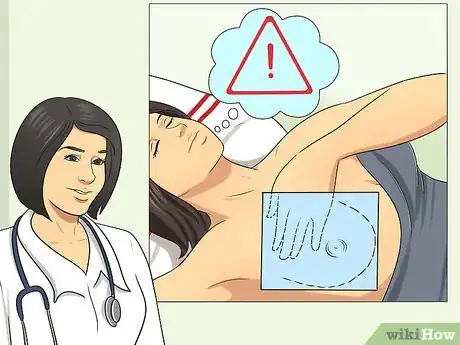

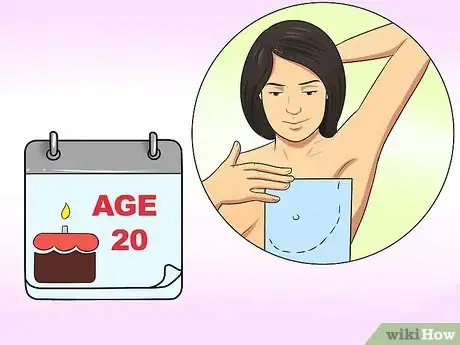

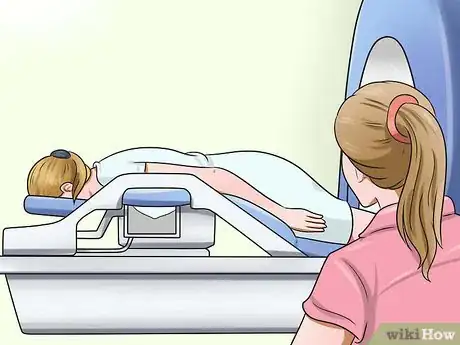
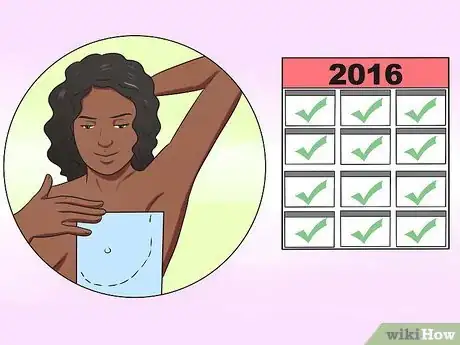
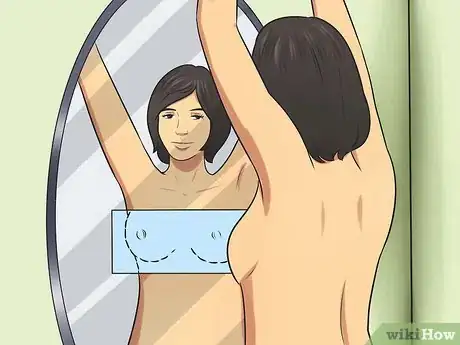


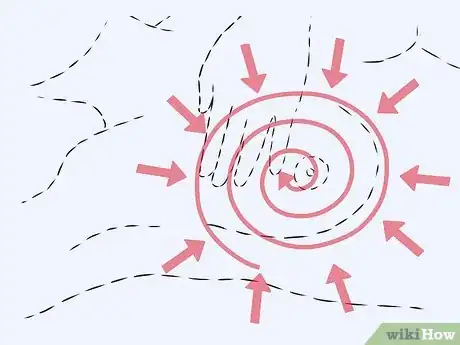


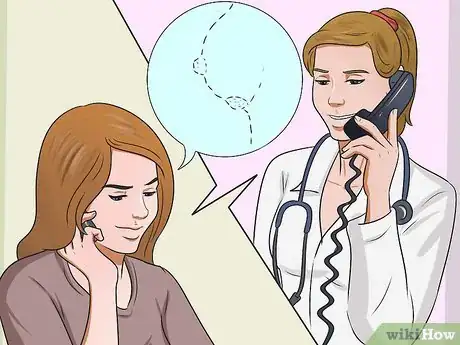

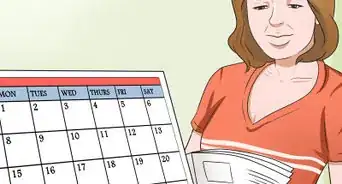




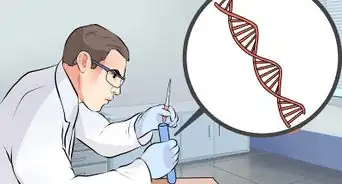

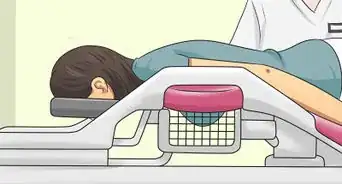










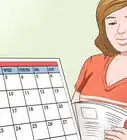





































Medical Disclaimer
The content of this article is not intended to be a substitute for professional medical advice, examination, diagnosis, or treatment. You should always contact your doctor or other qualified healthcare professional before starting, changing, or stopping any kind of health treatment.
Read More...